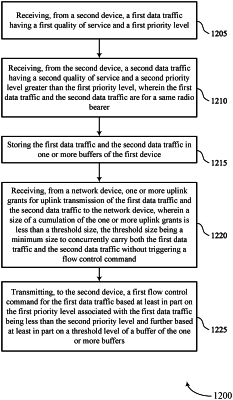| CPC H04L 47/2433 (2013.01) [H04L 47/2416 (2013.01); H04W 28/0257 (2013.01); H04W 28/0268 (2013.01)] | 30 Claims |

|
1. A method for wireless communication at a first device, comprising:
receiving, from a second device, a first data traffic having a first quality of service and a first priority level;
receiving, from the second device, a second data traffic having a second quality of service and a second priority level greater than the first priority level, wherein the first data traffic and the second data traffic are for a same radio bearer associated with a network device;
receiving, from the network device, one or more uplink grants;
storing the first data traffic and the second data traffic in one or more buffers of the first device;
transmitting, to the second device, a first flow control command for the first data traffic and a second flow control command for the second data traffic based at least in part on the first priority level associated with the first data traffic being less than the second priority level and further based at least in part on a threshold level of a buffer of the one or more buffers and further based at least in part on a size of the one or more uplink grants, wherein the first flow control command indicates a first data rate for the first data traffic, and wherein the second flow control command indicates a second data rate for the second data traffic;
receiving, from the second device, the first data traffic according to the first data rate;
receiving, from the second device, the second data traffic according to the second data rate, wherein the second data rate is different from the first data rate; and
transmitting, to the network device via the same radio bearer in accordance with the one or more uplink grants, the first data traffic based at least in part on the first data rate and the second data traffic based at least in part on the second data rate.
|